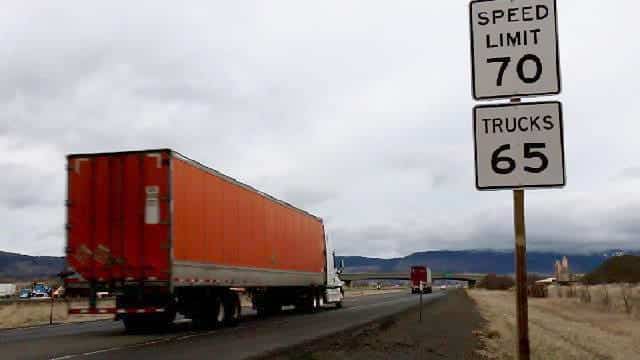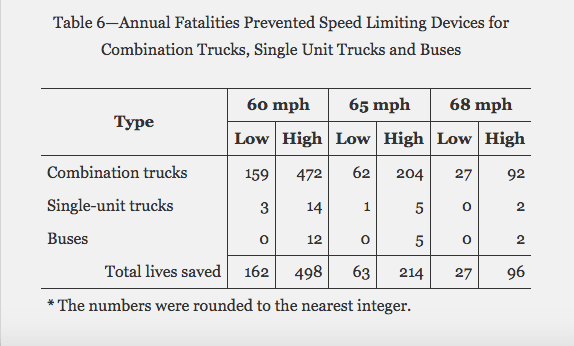The idea is that semi-trucks and other heavy commercial vehicles shouldn’t be able to speed on U.S. roads and highways.
In August, the National Highway Traffic Safety Administration and the Federal Motor Carrier Safety Administration jointly proposed that all new trucks, buses, and commercial passenger vehicles that weigh more than 26,000 pounds have speed limiting devices set to a specific maximum speed.

The proposed maximum speed has not yet been set. But it is likely between 60 and 68 miles per hour.
What Are Truck Speed Limiters?
Imagine a digital governor, nestled within a truck’s engine. That’s essentially what a speed limiter is. It electronically restricts the engine’s output, preventing the vehicle from exceeding a pre-set speed. Think of it as a safety net woven into the very fabric of commercial vehicle limiting the top speed of the vehicle.
What Does a Speed Limiter Do?
Beyond simply dictating pace, speed limiters offer a multitude of benefits:
- Enhanced Safety: By curbing excessive speeds, they reduce the risk of devastating truck wrecks. Remember, physics is unforgiving – the force of a collision increases exponentially with speed. Every mile per hour shaved off translates to potentially saved lives.
- Improved Fuel Efficiency: Maintaining a steady, moderate pace optimizes fuel consumption, benefitting both the trucking company and the environment. It’s a win-win for wallets and the planet.
- Reduced Driver Fatigue: Long hours on the road can lead to driver fatigue, a major contributor to accidents. Speed limiters encourage a more measured driving style, promoting alertness and focus behind the wheel.
The Case for Speed Limiters on Trucks
Each year there are numerous preventable commercial truck and bus crashes each year causing serious injuries and fatalities. From 2014-2015, truck crash deaths rose 4.1%.
Implementing speed limiting devices in heavy trucks would save lives.
Small increases in speed have large effects on the force of an impact. There is also a direct correlation between stopping distances and rate of speed.
The National Highway Traffic Safety Administration (NHTSA) analyzed crash data from 2004-2014. They found that crashes involving heavy vehicles traveling faster are more deadly than crashes involving heavy vehicles at lower speeds.
- On average, every year 1,044 people died in truck crashes on roads with speed limits of at least 55 mph.
- Capping truck speeds at to 60 mph would save between 162 to 498 lives per year.
- Capping speeds at 65 mph could save as many as 214 lives, because the impact of a crash would be less severe.
Many trucking companies already use speed governors voluntarily—and run efficient, profitable companies. Requiring speed limiters in across the industry levels the playing field.
In addition to the lives saved, the cost and energy savings are huge. Requiring speed limiters in trucks could save $1.1 billion and millions of gallons of fuel—every year.
Insurance costs would likely drop. And, the reduction in greenhouse gas emissions would be significant.
The American Transportation Association (ATA) has been pushing for speed limiter legislation for nearly a decade. The trucking group has urged safety regulators to look at limiting the speed of all vehicles—including passenger cars—to 65 mph.
“Federal data show that driving too fast for conditions or over the posted speed limit was the primary reason for 18% of all fatal crashes where a large truck was deemed at fault.”
The case against speed limiters
Other motor carriers and trucking associations claim that the proposed speed limiter rule will have no effect on public safety, but will increase costs on smaller and older fleets.
They argue that speed limiters alone may end up creating a whole other set of safety issues for the driving public.
The Owner-Operator Independent Driver’s Association (OOIDA) says speed limiters:
“… create(s) an artificial and unsafe speed differential between trucks and other highway users.
Faster-moving cars sharing the road with slower-moving trucks create an increased likelihood for collisions as other vehicles compete to pass speed limited trucks and attempt to enter or exit highways.”
Some argue that speed governing creates a road hazard when trucks running side by side can’t pass each other. This leads to rolling bottlenecks and traffic congestion, negating some of the theoretical benefits of a reduction in fuel use and emissions.
Finally, emerging technology, like forward collision avoidance mitigation (FCAM) and vehicle-to-vehicle communication, could quickly make speed limiters obsolete.
And, since older trucks would be exempt from the mandatory speed limiters, carriers would try to keep these trucks on the road for as long as possible.
Recommended Article: Accident I5
Pros and Cons of Speed Limiters:
While the advantages are undeniable, some argue that speed limiters come with their own set of drawbacks:
- Economic Impact: Critics claim they hinder delivery schedules and productivity, impacting the trucking industry and potentially raising consumer costs.
- Traffic Flow Disruption: Slower trucks could lead to congestion, especially on single-lane highways, potentially frustrating other motorists.
- Technological Concerns: Malfunctioning limiters or tampering could create safety hazards, highlighting the need for robust regulations and enforcement.
Frequently Asked Questions (FAQs) – Speed Limiters:
Does a Speed Limiter Save Fuel?
Absolutely! Maintaining a constant, moderate speed optimizes fuel combustion, leading to significant savings for trucking companies. Studies have shown fuel efficiency improvements of up to 6%, translating to substantial cost reductions for both trucking companies.
What is Mandatory Speed Limiters?
Currently, there is no federal mandate for speed limiters in the United States. However, some states have implemented their own regulations, and the debate on a national mandate continues. Proponents tout the safety benefits, while opponents’ express concerns about economic impact, vehicle accidents and potential unintended consequences of distracted driving.
What States Have 80 mph Speed Limits?
Only a handful of states in the US boast 80 mph speed limits for certain stretches of highway. These states Montana, Nevada, South Dakota, Utah, and portions of Texas, Oklahoma, Wyoming, and Idaho. These are typically rural interstates with minimal traffic congestion and optimal driving conditions. Remember, even in these states, lower limits often apply in urban areas and on secondary roads.
How do Speed Limiters Work?
Think of a speed limiter as a digital governor within a truck’s engine. It electronically restricts fuel flow or power output, preventing the vehicle from exceeding a pre-set speed limit. Imagine a truck driver with cruise control set to a specific maximum, but one that can’t be overridden by pressing the accelerator further.
Can Speed Limiters be Disabled?
While tampering is technically possible, it’s illegal and comes with hefty fines and potential safety hazards. Modern limiters are sophisticated, often employing tamper-proof seals and onboard diagnostics to track any attempts at disabling them. Trucking companies also face penalties for non-compliance, making tampering a risky proposition for the truck company.
How Does a Speed Limiter Work Technically?
The specific technology varies, but most speed limiters fall into two categories:
- Engine Control Unit (ECU) Based: These integrate with the truck’s ECU, directly controlling fuel injection or air intake to limit engine power.
- Vehicle Speed Sensor Based: These monitor the truck’s speed through sensors on the wheels or axles and trigger automatic power reduction if the pre-set limit is approached.
What is NTSB Speed Limiting Technology?
The National Transportation Safety Board (NTSB) advocates for mandatory speed limiters in heavy trucks, citing their potential to significantly reduce truck-related accidents. They recommend specific technologies and performance standards to ensure effectiveness and reliability.
What is the Device for Limiting Speed?
The official term for a speed limiter in passenger cars and heavy trucks is an Electronic Control Module (ECM) or an Intelligent Speed Adaptation (ISA) system. Some manufacturers might use their own brand names, but they all essentially serve the same purpose in commercial trucks: electronically controlling a truck’s maximum speed.
What is Speed Limit Assist Technology?
Speed limit assist is a broader term encompassing various driver-assistance features that help maintain a safe speed. This could include:
- Traffic Sign Recognition: Automatically reads posted speed limits and displays them on the dashboard.
- Adaptive Cruise Control: Maintains a set distance from the vehicle ahead while respecting posted speed limits.
- Lane Departure Warning: Alerts the driver if they drift out of their lane, potentially due to inattentiveness or exceeding the safe speed for the road.
Remember, even with advanced technology, driver vigilance, training and experience remain crucial. Speed limiters and driver-assistance features are valuable tools, but they shouldn’t replace responsible driving practices.
Recommended Article: Truck Accident Lawsuit
Conclusions
The rumble of the debate surrounding truck speed limiters is unlikely to fade anytime soon. While the technology offers undeniable safety advantages, concerns about economic impact and implementation challenges deserve careful consideration. Ultimately, finding the right balance between safety, efficiency, and practicality for commercial trucks will be crucial in determining the future of these digital governors.
Remember, if you’ve been involved in a truck or car accident yourself, don’t face the complexities alone. An experienced truck accident lawyer at Coluccio Law firm can help navigate the legal landscape and fight for the compensation you deserve. Contact us today for a free consultation and let our expertise guide you through this challenging time.
What is Next?
The speed limiter rule has been in progress for years. But it hasn’t progressed enough to be shielded from the potential changes of the impending Trump administration.
Senator Chuck Schumer (D-NY) has asked FMCSA to act quickly on the proposed rule.
For more than 30 years, I have handled truck and bus crash cases in the Pacific Northwest: so many of these crashes involve excessive speed. I think about these crashes when I drive at the speed limit on I-5 or 1-90 on a rainy day, and semi-trucks cruise past me.
“Safety first” is a theme I’ve often heard from motor carriers and trucking associations. This proposal puts that principle front and center.
It may not be a perfect solution, but speed limiters are a win for safety, cost savings and our environment.
Also Read: Where Do Broadside Collisions Most Commonly Occur?






2 Responses
Speeding limiting creates safety hazards for motorist a truck running 65 mph in a 70 mph speed limit a car or passenger vehicle doing 75 runs up on said truck needs to change lanes but can’t and collides with the car beside or reAr ends the truck both cars end up in trucks lane and boom fatality collision caused by speed limiter. Entering a on ramp same circumstance, two trucks passing each other but takes 7 miles to get it done because speed limiter there is a 7 to 8 minute road hazard that could be avoided if one truck could pass the other expediently. Not to mention most crashes involving semis are caused by passenger vehicles weaving in and out of traffic or talking and texting on phone or the occasional adult behavior in the vehicle while traveling. Legislature has been in the industry for years creating more problems for it than it solves not to mention driving cost up for the companies doing business. The problem is we have people who have no clue about what they speak of because they have never been in a truck to see the real problems but think they can make decision because seen a study or a colleague informed them or my favorite I went to college so I know what I’m doing. I have done this job for many years and can tell you there is no easy fix to safety because each one of us have to be committed to it no matter what you drive. We can however make a big dent by mandating better education for passenger vehicle driver as to the pit falls of semis what that can and can’t do and how not to put yourself in harms way by knowing what to do when approaching a truck and law enforcement writing tickets for impeding traffic improper lane changes texting while driving using laptops and other driving distractions that happen everyday by individuals in all vehicles. Tackle real issues and get input from experienced drivers who have real knowledge of the problems those of us who spend our days 8,10, 12 hours a day on the road not someone who drives a average of 1 hour a day.
I would argue that speed limiters in commercial vehicles add to driver fatigue as it takes longer for a driver to get to their destination. It also causes a driver to encounter more vehicles attempting to pass commercial vehicles with speed limiters. A driver going with the flow of traffic, is on and off the highway in a much safer manner than impeding traffic for longer periods of time.
I would certainly advocate for more driver education for commuters about the dangers of certain driving behaviors around commercial vehicles. All too often, a vehicle passing me up, changes lanes directly in front of me, taking up my stopping distance. This causes me to have to slow, and impede traffic even further, to reclaim stopping distance.